Related Research Articles
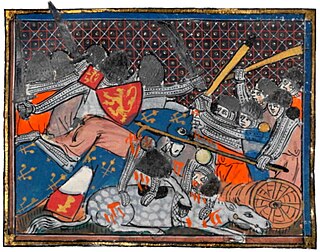
Year 1302 (MCCCII) was a common year starting on Monday of the Julian calendar.

Year 1304 (MCCCIV) was a leap year starting on Wednesday of the Julian calendar.

The Battle of the Golden Spurs or 1302 Battle of Courtrai was a military confrontation between the royal army of France and rebellious forces of the County of Flanders on 11 July 1302 during the 1297–1305 Franco-Flemish War. It took place near the town of Kortrijk in modern-day Belgium and resulted in an unexpected victory for the Flemish.
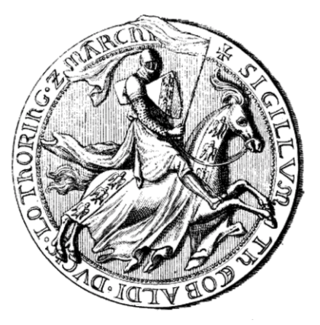
Theobald II was the Duke of Lorraine from 1303 until his death in 1312. He was the son and successor of Frederick III and Margaret, daughter of King Theobald I of Navarre of the Royal House of Blois.

Guy of Dampierre was the Count of Flanders (1251–1305) and Marquis of Namur (1264–1305). He was a prisoner of the French when his Flemings defeated the latter at the Battle of the Golden Spurs in 1302.
Guy of Dampierre, Count of Zeeland, also called Guy of Namur, was a Flemish noble who was the Lord of Ronse and later the self-proclaimed Count of Zeeland. He was a younger son of Guy, Count of Flanders and Isabelle of Luxembourg.
Pierre Flotte or Pierre Flote was a French legalist, Chancellor of France and Keeper of the Seals of Philip IV the Fair. He was taught Roman law at the University of Montpellier, and was considered one of the best lawyers and legalists of his time. He led negotiations with the Roman Curia, England and Germany.
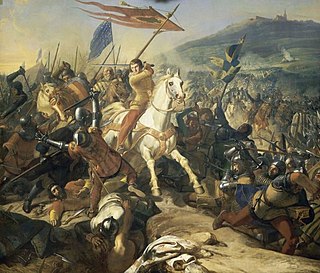
The Battle of Mons-en-Pévèle was fought on 18 August 1304 between the French and the Flemish. The French were led by their king, Philip IV.
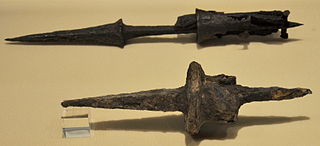
A goedendag was a weapon originally used by the militias of Medieval Flanders in the 14th century, notably during the Franco-Flemish War. The goedendag was essentially a combination of a club with a spear. Its body was a wooden staff roughly 90 cm to 150 cm long with a diameter of roughly 5 cm to 10 cm. It was wider at one end, and at this end a sharp metal spike was inserted by a tang.

Pieter de Coninck was a weaver from Bruges well known for his role in the events surrounding the Battle of the Golden Spurs. He was not the head of the weavers' guild as is popularly believed. Together with Jan Breydel, a butcher, he was in the forefront of the popular uprising that led to the Battle of the Golden Spurs. Right before that battle he was knighted together with two of his sons.
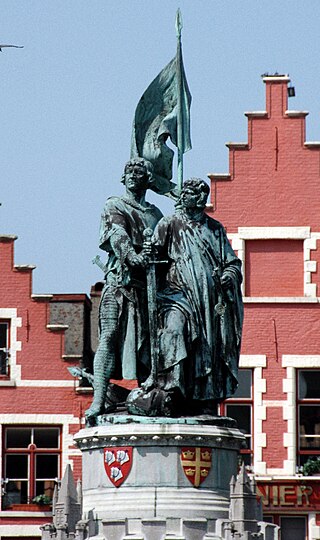
Jan Breydel is credited with leading the Bruges Matins, a violent uprising against Philip the Fair. He is said to have played a major role in the Franco-Flemish War, even though his authenticity has since been questioned.

The Matins of Bruges was the nocturnal massacre of the French garrison in Bruges and their Leliaards supporters, a political faction in favour of French rule, on 18 May 1302 by the members of the local Flemish militia. It has been named "Matins" in analogy to the Sicilian Vespers of 1282. The revolt led to the Battle of the Golden Spurs, which saw the Flemish militia defeat French troops on 11 July 1302.
Jacques de Châtillon or James of Châtillon was Lord of Leuze, of Condé, of Carency, of Huquoy and of Aubigny, the son of Guy III, Count of Saint-Pol and Matilda of Brabant. He married Catherine of Condé and had issue.
The Treaty of Melun was signed in April 1226 between Louis VIII of France and Joan, Countess of Flanders.
Isabelle of Luxembourg was a countess consort of Flanders and a marquise consort of Namur by marriage to Guy of Dampierre.

Year 1304 (MCCCIV) was a leap year starting on Wednesday of the Julian calendar.

On 23 August 1328, the Battle of Cassel took place near the city of Cassel, 30 km south of Dunkirk in present-day France. Philip VI fought Nicolaas Zannekin, a wealthy farmer from Lampernisse. Zannekin was the leader of a band of Flemish rebels. The fighting erupted over taxation and punitive edicts of the French over the Flemish. The battle was won decisively by the French. Zannekin and about 3,200 Flemish rebels were killed in the battle.
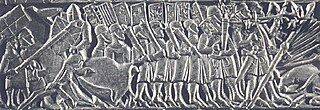
The Franco-Flemish War was a conflict between the Kingdom of France and the County of Flanders between 1297 and 1305.

Simon II of Clermont-Nesle was Seigneur (Lord) of Ailly, Maulette and Nesle
The siege of Tournai was an event of the Franco-Flemish War in 1303.
References
- ↑ "Philip IV Biography, Facts, & Accomplishments". www.britannica.com. Retrieved 26 December 2024.
- ↑ John Mackintosh, The History of Civilisation in Scotland (Alexander Gardner, 1892) p. 274
- ↑ "Boniface VIII", by Thomas Oestreich, in The Catholic Encyclopedia, ed. by Charles G. Herbermann (The Encyclopedia Press, 1907) p.666
- ↑ The Pope's instructions for the Legate survive: Pierre Dupuy, Histoire du differend "Preuves", pp. 88-92.
- ↑ Llewellyn, Jennifer; Thompsontitle, Steve (2012-11-19). "The Estates General". Alpha History: French Revolution. Retrieved 2021-04-26.
- ↑ Andrew Latham (2019). "Medieval Geopolitics: The Conflict between Pope Boniface VIII and King Philip IV of France". Medievalists.net.
- ↑ Tucker, Spencer C. (2010). A Global Chronology of Conflict, p. 294. Vol. 1. ISBN 978-1-85-109667-1.
- ↑ Verbruggen, J. F. (2002). The Battle of the Golden Spurs: Courtrai, 11 July 1302, p. 192. Woodbridge: Boydell Press. ISBN 978-0-85115-888-4.
- ↑ "Battle of the Golden Spurs | Flanders, 1302, Flemish Victory | Britannica". www.britannica.com. Retrieved 2024-12-26.
- ↑ Verbruggen, Jan Frans. DeVries, Kelly (ed.). De slag der Guldensporen. Bijdrage tot de geschiedenis van Vlaanderens vrijheidsoorlog, 1297-1305[The Battle of the Golden Spurs (Courtrai, 11 July 1302)] (in Flemish). Translated by Ferguson, David Richard. Boydell & Brewer.
- 1 2 3 4 5 6 7 8 9 10 11 Johnstone, Hilda, ed. (1985). Annales Gandenses: Annals of Ghent (Repr. ed.). Oxford: Clarendon. p. 31. ISBN 0-19-822211-4.